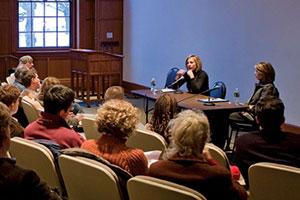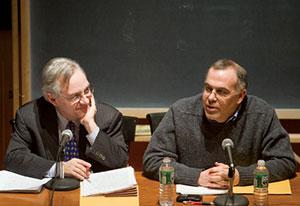Back when Mitt Romney was still a contender and superdelegate was not yet a household word, four big names in punditry came to Amherst to lead Interterm Colloquia—mini-courses and public talks—on politics and the presidential race.
 Speakers Dee Dee Myers (left) and Nicolle Wallace (right). |
For two days, Dee Dee Myers, who was press secretary to President Clinton, and Nicolle Wallace, former White House communications director under George W. Bush, shared a table to talk about “Hot Buttons—and Who’s Pushing Them: Women, the Media and the Changing Electorate.” The following week, columnists David Brooks of The New York Times and E. J. Dionne of The Washington Post presented a two-day colloquium on “What Do We Mean by ‘America’? Liberalism, Conservatism and the Future of the Culture Wars.”
Myers and Wallace offered the inside scoop on life inside the White House and on the campaign trail. Their public forum, held in a full Pruyne Lecture Hall, centered on “hyper-partisanship.” It was no cable-style screaming match: Myers and Wallace spent more time agreeing with each other than disagreeing.
Myers said political parties “find that there’s more to be gained from stoking the base than finding compromise.” Once partisan lines get drawn on issues such as Iraq and immigration, they’re almost impossible for politicians to cross. “The voters have to decide they want something different,” Myers said, “and we haven’t. We say we do, but we don’t demand that the candidates find middle ground.” Both women pointed the finger at the press. “The media loves a good fight,” Myers said. “The thing it doesn’t do is try to weigh the value of both arguments.” Wallace blamed the media for turning policy debates into “conflict narratives,” but she, like Myers, also criticized the public, arguing that the visceral feelings of love and hate that Americans have for political leaders contribute to an unhealthily partisan society.
Warning that the country faces “a total disintegration of civilized debate,” Wallace reminisced about the days when Republicans and Democrats used to “fight in Washington and then have drinks together afterwards.” She spoke hopefully of a McCain nomination (which, at that point, was far from secure), saying he had the potential to lead the country into an era of post-partisanship. But at the same time, she wondered, “Are we ready to give up our corner and move to the center? My hunch is that we’re probably a couple of cycles away.”
 Columnists E.J. Dionne (left) and David Brooks (right). |
The two-day Brooks-Dionne colloquium featured cultural commentary on the presidential race, which Brooks called “the most exciting political campaign of our lifetime.” At the public forum, held in a packed Cole Assembly Room, Brooks said there’s no doubt the United States is rigidly segmented—by lifestyle, religion, education level. But during this campaign season, he’s been struck by the extent to which the big concerns are the same for everyone—global warming, health care, the economy and, overlaying everything else, a feeling that “we’ve been failed by one authority structure after another.”
Dionne gave specific advice to the Democratic Party: in order to win, he argued, the left must embrace the liberal label. “I believe this is fundamentally a moderate nation, culturally,” he said. But he argued that part of finding the nation’s political middle—and “putting the culture wars behind us”—is recognizing that the “liberalism that emerged in the civil rights movement, the New Deal and the Progressive era was not simply a set of good intentions, but an essential concept that created the America that conservatives and liberals now embrace.”
The mini-courses left students with more than just sound bites. “One of the nice things,” said Lawrence Douglas, the James J. Grosfeld Professor of Law, Jurisprudence and Social Thought, who led the Myers-Wallace colloquium, “is that when you have something lasting for hours, it forces you to break the script.” As Claire Rann ’08, who took part in the Brooks-Dionne program, put it, “It really felt like a two-way street instead of just being talked at for two days.”
Photos by Samuel Masinter '04